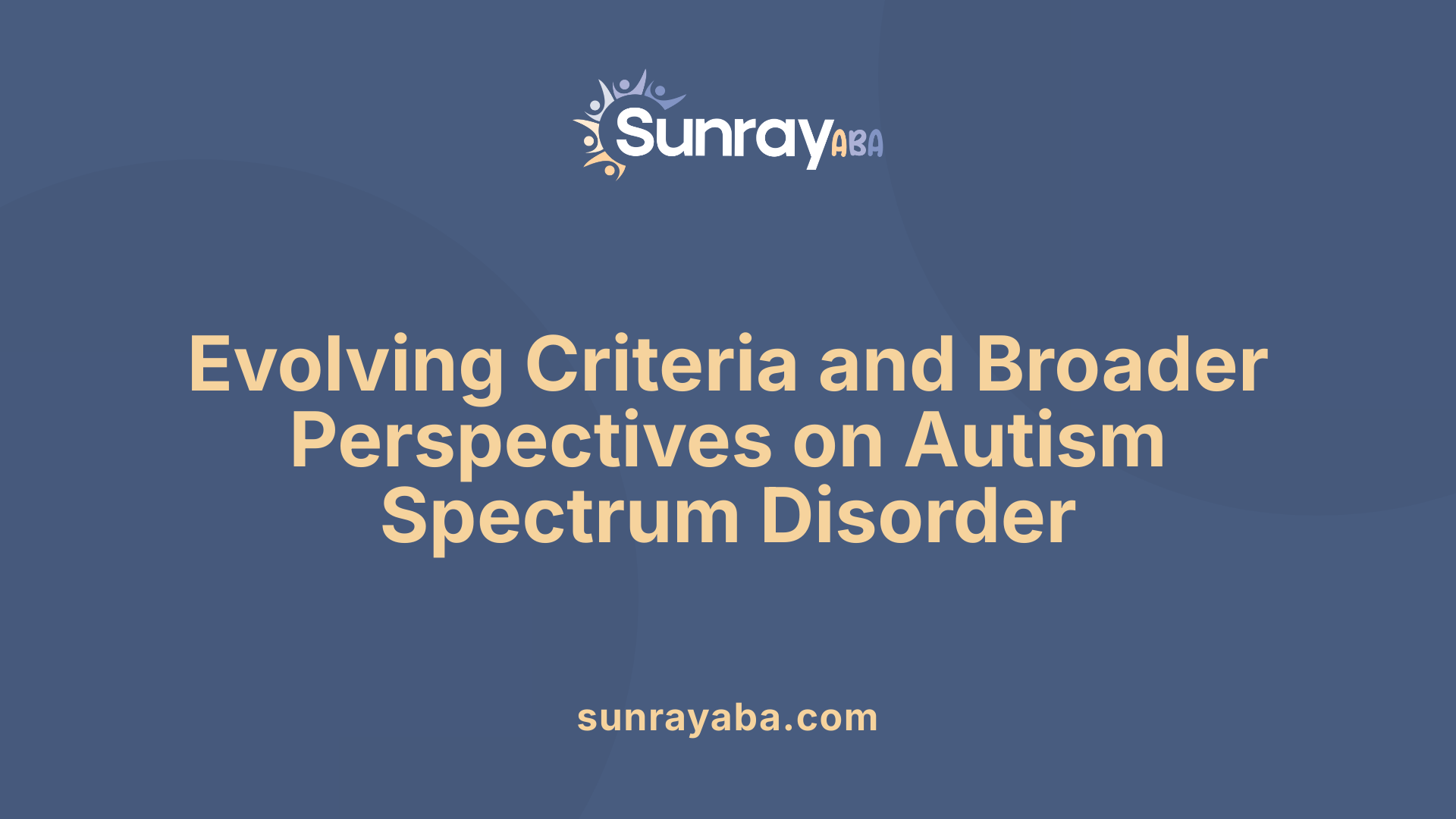Autism and Narcissism

An Overview of Autism and Narcissism
Autism spectrum disorder (ASD) and narcissistic traits are fundamentally different yet sometimes superficially overlapping conditions that can cause confusion in diagnosis and understanding. While ASD is a neurodevelopmental disorder identified early in childhood, narcissistic traits and disorders typically emerge in adolescence or adulthood. Grasping the distinctions, similarities, and potential overlaps between these conditions is crucial for mental health professionals, educators, and families to foster accurate assessments and effective support.
Diagnosing Autism and Narcissism: Timing and Characteristics

When is autism typically diagnosed, and what are its signs?
Autism Spectrum Disorder (ASD) can often be diagnosed accurately as early as ages two to three. Signs include difficulties with social communication, such as limited eye contact, challenges in understanding social cues, delayed speech development, and restricted interests or repetitive behaviors like hand-flapping or rearranging objects. Children with autism may also show sensory sensitivities and trouble engaging in imaginative play. These early behavioral differences are usually noticeable and help with early intervention. However, sometimes signs can be mistaken for other issues or appear later, making awareness crucial.
Why must pathological narcissism be diagnosed after adolescence?
Pathological narcissism, specifically Narcissistic Personality Disorder (NPD), cannot reliably be diagnosed before adolescence. This is because narcissistic traits—such as grandiosity, entitlement, and a need for admiration—generally develop over time and become stable in early adulthood. Moreover, many narcissistic behaviors can appear in adolescents as part of normal developmental processes but do not reach clinical significance until the traits are pervasive, persistent, and impairing. Thus, clinicians prefer to assess NPD after individuals have reached maturity, often in their late teens or early adulthood.
Overlap and Distinctions in Behavioral Manifestations

What are the key differences and similarities between autism and narcissistic traits?
Autism spectrum disorder (ASD) and narcissistic traits both involve difficulties in social interactions, which can sometimes lead to confusion or misinterpretation. Autism is primarily a neurodevelopmental condition marked by challenges with social communication, limited interests, and sensory processing issues. Individuals with autism often struggle to understand social cues, initiate and sustain conversations, or interpret body language.
In contrast, narcissistic traits—often associated with narcissistic personality disorder (NPD)—center around a grandiose sense of self, entitlement, and a lack of empathy for others. These traits include a need for admiration, arrogance, and often, manipulative behaviors to maintain a sense of superiority.
While distinct, these conditions can exhibit superficial behavioral overlaps, especially in social withdrawal and sensitivity to criticism. Recognizing that autism involves neurodevelopmental deficits whereas narcissism pertains to personality traits is crucial for accurate diagnosis and providing appropriate support.
Autism Spectrum Disorder: Broadening Perspectives and Diagnostic Criteria

Inclusion of Asperger’s syndrome in ASD
According to recent diagnostic manuals like DSM-5, Asperger’s syndrome is now considered part of Autism Spectrum Disorder (ASD). This change means that Asperger’s no longer receives a separate diagnosis, highlighting the spectrum nature of autism. Individuals previously diagnosed with Asperger’s are now classified under ASD, provided they exhibit characteristic behaviors such as social difficulties and restricted interests.
Shift in diagnostic criteria over time
Over recent years, the criteria for diagnosing autism have expanded to encompass a broader range of behaviors and severities. Early diagnoses focused on obvious developmental delays, but now clinicians recognize that many traits may be subtle or manifest later in childhood. As a result, adults can now be diagnosed with autism, which can provide clarity on prior social struggles and behaviors that might have been misunderstood.
Impact on recognition and diagnosis
The broadened criteria and inclusion of Asperger’s have improved recognition across diverse populations. Many individuals with high-functioning autism or milder symptoms can now access support and interventions earlier. However, the overlaps that sometimes occur between autism traits and narcissistic behaviors can complicate diagnosis if not carefully assessed.
Differences and similarities between autism and narcissistic traits
Autism and narcissism can show some superficial overlaps in social behavior, such as limited social interests or withdrawal. Autism involves specific neurodevelopmental challenges including difficulties with nonverbal cues, repetitive behaviors, and sensory issues. Conversely, narcissistic traits often include grandiosity, entitlement, and a lack of empathy—traits that generally develop later and involve a desire for admiration.
Despite differences, both conditions may involve social withdrawal, anxiety, and self-involvement. Autistic individuals often struggle with understanding social norms not due to choice but because of cognitive deficits. In contrast, narcissistic individuals may regulate their social behavior consciously to maintain self-image.
Overlap and distinctions in behavioral observations
Research indicates that autistic individuals can sometimes exhibit traits similar to narcissism, such as hypersensitivity to criticism, self-absorption, or reluctance to admit mistakes. However, underlying motivations differ: autism’s social difficulties stem from neurodevelopmental deficits, whereas narcissistic behaviors relate to personality traits centered around self-esteem regulation.
Diagnostic and research insights into comorbidity
Recent studies have explored the relationship between ASD and narcissism. Findings show that adults with ASD tend to score higher on measures of vulnerable narcissism—characterized by insecurity, sensitivity, and need for validation—though they do not show heightened grandiose narcissism. About 28.7% of autistic individuals scored above the 90th percentile for potential narcissistic traits, suggesting significant overlap in vulnerability.
Furthermore, research suggests that up to 68% of autistic people might meet criteria for at least one personality disorder; yet, specific co-occurrence with Narcissistic Personality Disorder (NPD) remains relatively low at approximately 0-6.4%. Such findings highlight that while traits can overlap, true comorbid diagnoses are relatively rare.
The diagnosing process and differentiating behaviors
Clinicians distinguish between autism and narcissism by examining developmental history, social motivation, and behavior patterns. Autistic individuals display communication difficulties, repetitive behaviors, and limited interests that originate early in life. In contrast, narcissistic traits often emerge later, characterized by a need for admiration, grandiosity, and emotional regulation issues.
Probing into the motivations behind social difficulties helps in differentiation. Autism's social challenges are rooted in neurodevelopment, while narcissistic behaviors involve deliberate self-enhancement and manipulation.
Common co-occurring conditions and behaviors
Despite distinctions, some overlapping social behaviors exist. Autistic individuals may show self-involvement, difficulty understanding social cues, and hypersensitivity to criticism—traits that may superficially resemble narcissistic features.
Research also indicates that some autistic individuals score higher on measures of vulnerable narcissism, which includes feelings of insecurity and emotional sensitivity. However, the causation and underlying motivations differ fundamentally between the two conditions.
Typical symptoms and how to distinguish
Autism Spectrum Disorder involves persistent difficulties with social communication, repetitive behaviors, sensory sensitivities, and restricted interests. Common traits include challenges with eye contact, gestures, and understanding social cues.
Narcissism, especially NPD, involves traits such as grandiosity, fantasies of power or success, lack of empathy, and a constant need for admiration. Unlike autism, narcissistic traits are often associated with an inflated self-image.
Adult assessments show that individuals with ASD often score higher on vulnerable narcissism—marked by insecurity and avoidance—rather than grandiose narcissism, which features arrogance and entitlement.
Importance of accurate differentiation
Correct diagnosis is crucial for effective intervention. Understanding whether behaviors stem from neurodevelopmental deficits or personality traits guides tailored support strategies.
Comprehensive assessments include developmental history, behavioral observations, and personality testing. This helps teachers, clinicians, and families develop appropriate approaches, fostering better social understanding and mental health outcomes.
In summary, while autism and narcissistic traits can share superficial features such as social withdrawal or self-involvement, their underlying causes, developmental timelines, and characteristic behaviors differ significantly. Recognizing these differences ensures that individuals receive appropriate diagnosis, support, and treatment tailored to their specific needs.
Autism Spectrum Disorder: Broadening Perspectives and Diagnostic Criteria

Inclusion of Asperger’s syndrome in ASD
Since the DSM-5, Asperger’s syndrome is no longer diagnosed separately but is considered part of Autism Spectrum Disorder (ASD). This revision reflects a broader understanding that ASD encompasses a range of behavioral and developmental features previously classified separately. Individuals who might have been diagnosed with Asperger’s now fall under a unified diagnosis, which helps streamline assessment and intervention. This change emphasizes the spectrum nature of autism, recognizing that traits can vary widely among individuals.
Shift in diagnostic criteria over time
Over recent years, diagnostic criteria for ASD have evolved to include a wider array of symptoms and presentations. The DSM-5 criteria focus less on specific behaviors like repetitive movements alone and incorporate social communication deficits and sensory sensitivities. This shift allows for earlier and more accurate diagnoses, including in adults, who might have previously gone unidentified. Recognizing autism in adulthood can provide critical insights into lifelong social struggles, sometimes mistaken for narcissistic traits.
Impact on recognition and diagnosis
The broadened criteria and inclusion of conditions like Asperger’s have increased recognition of autism across age groups. It has also highlighted the importance of understanding overlapping features with other conditions such as narcissism. Accurate diagnosis ensures that individuals receive the appropriate support, especially since autistic traits such as social withdrawal, limited interests, and difficulty interpreting social cues can resemble narcissistic behaviors.
How autism and narcissistic traits compare
While both autism and narcissism can involve self-involvement, social difficulties, and limited interests, their roots and manifestations differ.
| Aspect | Autism | Narcissism | Difference | Similarity | |---------|---------|------------|------------|------------| | Core nature | Neurodevelopmental disorder | Personality disorder / traits | Autism involves cognitive and communication deficits, narcissism involves self-esteem regulation and social manipulation | Both may involve social withdrawal and insensitivity | | Social communication | Difficulties understanding nonverbal cues, initiating conversations | Superficial social skills, often strategically regulated | Autism is due to developmental challenges; narcissism is intentional or trait-based | | Empathy | Often impaired due to cognitive deficits | Generally lacking or superficial, with disregard for others | Impairments in empathy are common to both but stem from different causes | | Repetitive behaviors and interests | Present, including stimming and intense focus | Not characteristic of narcissism | Repetitiveness is specific to autism, not narcissism | | Behavior in social settings | Struggles with social norms, difficulty in relationships | Seeks admiration, exploits others | Differentiated by motivation and underlying intent |
Can an individual have both autism and narcissistic traits or disorders simultaneously?
Yes, coexistence is possible, although they are distinct conditions. Studies suggest autistic individuals may exhibit higher levels of vulnerable narcissism, characterized by sensitivity and insecurity, rather than grandiosity. This overlap can complicate diagnosis since behaviors like social withdrawal, sensitivity to criticism, and limited social understanding appear in both.
Research indicates that about 28.7% of autistic individuals score above the 90th percentile for narcissistic traits, especially vulnerable narcissism. Such findings imply a potential comorbidity or at least a symptom overlap worth careful consideration by clinicians.
While the core causes of autism and narcissistic traits differ—neurodevelopmental vs. personality-based—their behavioral manifestations can sometimes mimic each other, especially in adults where developmental histories are less accessible.
How can clinicians differentiate between autism and narcissistic behaviors?
Differentiation relies on understanding development, motivations, and specific symptom patterns. Autism typically presents early in childhood with signs like delayed speech, repetitive movements, and challenges with nonverbal communication. These are rooted in neurodevelopmental differences.
Narcissistic behaviors, on the other hand, often emerge later, linked to personality development, and include traits like grandiosity, entitlement, and superficial empathy. An adult who seeks admiration but lacks genuine empathy and shows manipulative tendencies likely exhibits narcissistic traits.
Clinicians should gather thorough developmental histories, observe social interactions, and use standardized assessments. Recognizing whether behaviors stem from neurodevelopmental deficits or personality traits is crucial for effective support.
Are there common co-occurring conditions or behaviors between autism and narcissism?
Although both conditions are separate, some overlapping behaviors include self-focused behaviors, difficulty understanding social cues, and hypersensitivity to criticism. These may superficially resemble narcissistic traits but are driven by different underlying mechanisms.
Autistic individuals may appear self-involved or insensitive due to social communication difficulties. They may also show rigid behaviors, which can be mistaken for the entitlement seen in narcissism.
Research hints that vulnerable narcissism, characterized by internal emotional struggles and sensitivity, may be more prevalent among autistic populations than previously recognized. However, true co-occurrence remains relatively rare.
What are the typical symptoms and traits of autism and narcissism, and how can they be distinguished?
Autism Traits:
- Challenges in social communication and understanding social norms
- Repetitive behaviors like hand-flapping or rocking
- Limited interests and intense focus
- Sensory sensitivities
- Difficulties initiating or maintaining conversations
Narcissism Traits:
- Grandiosity and inflated self-view
- Need for admiration and validation
- Lack of empathy for others
- Entitlement and manipulativeness
Distinguishing these involves examining motivations: autism behaviors are primarily due to neurodevelopmental differences, whereas narcissistic behaviors often aim for validation or dominance. For example, an autistic person may struggle to make eye contact due to sensory overload, while a narcissist might avoid eye contact to manipulate or enhance their image.
Clinicians carefully evaluate history, behavioral patterns, and underlying motivations to differentiate these conditions. Understanding these distinctions ensures individuals receive appropriate intervention tailored to their needs.
Navigating perceptions and supporting differentiated diagnoses
Understanding the distinctions and overlaps between autism and narcissism is vital for accurate diagnosis and effective intervention. While some superficial behaviors may overlap, underlying motivations, developmental histories, and core symptoms differ markedly. Awareness of these differences helps reduce misconceptions, supports tailored therapeutic strategies, and promotes a better understanding of individuals on the autism spectrum and those with narcissistic traits. Recognizing the potential for co-occurrence, especially with vulnerable narcissism, underscores the importance of comprehensive assessment and nuanced support. Ultimately, distinguishing these conditions fosters more compassionate, effective approaches to mental health and social integration.
References
- Narcissism and Autism - Songbird Therapy
- Asperger's and Narcissism: Similarities and Differences - Healthline
- Traits of narcissistic vulnerability in adults with autism spectrum ...
- A Narcissism and Autism Connection? One Family's Experience
- Traits of narcissistic vulnerability in adults with autism spectrum ...
- Understanding The Difference Between Autism and Narcissism
- Traits of narcissistic vulnerability in adults with autism spectrum ...
- Asperger's and Narcissism: Similarities and Differences - Healthline